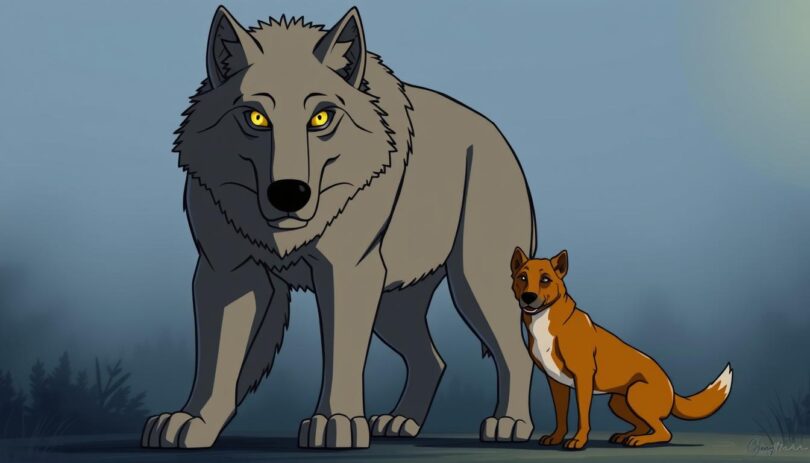What if everything you thought about your dog’s ancestry was only half the story? Though they share a genetic blueprint, the evolutionary paths of wolves and domestic canines have created two remarkably distinct animals. This guide dives into their physical contrasts, revealing how thousands of years of adaptation shaped their bodies, behaviors, and roles in nature.
While both belong to the same family, selective breeding and environmental pressures have led to striking variations. Wild relatives retain leaner frames and heightened survival instincts, while domesticated companions reflect human-driven traits like loyalty and adaptability. These differences go beyond appearances—they highlight the delicate balance between nature and nurture.
Understanding these distinctions isn’t just about curiosity. For pet owners, it offers insights into behavior patterns and care needs. Explore how dog care tips align with their biological heritage, bridging the gap between wild origins and modern companionship.
From skeletal structures to survival strategies, this comparison uncovers why size matters in the animal kingdom. Discover how evolution crafted one species for wilderness and another for human partnership—and what that means for your furry friend today.
The History and Evolution of Wolves and Dogs
Scavenging near early human settlements marked the first step in a transformative journey. Over 15,000 years ago, bold canines began lingering near campfires, drawn by discarded food. This interaction sparked a bond that reshaped both species forever.
Domestication and Genetic Roots
Early humans didn’t intentionally create companions—nature did. Less fearful individuals thrived near tribes, passing down traits like curiosity and adaptability. Genetic studies reveal these pioneers shared 99% of their DNA with wild counterparts, yet that 1% divergence holds the key to modern diversity.
Remarkably, most recognizable dog breeds emerged recently. While initial domestication spanned millennia, selective breeding accelerated changes. Victorian-era enthusiasts developed over half of today’s breeds through targeted pairing.
Evolutionary Divergence Over Time
Survival strategies split these cousins irrevocably. Wild populations maintained lean builds and keen instincts for hunting. Domestic lines developed smaller statures, varied coat types, and social behaviors aligning with human rhythms.
This split explains why certain working breeds retain wolf-like features, while others showcase exaggerated traits. From compact dachshunds to towering mastiffs, human influence sculpted canine forms far beyond nature’s original blueprint.
wolf vs dog size: Comparing Physical Builds and Measurements
Physical differences between these canids go beyond simple measurements. Evolutionary paths shaped their bodies for distinct purposes—one optimized for survival, the other for partnership. Let’s explore how anatomy reflects their roles in nature and human society.
Weight, Height, and Body Structure
Adult male wolves often tip scales at 70-145 pounds—similar to giant domestic breeds. However, their lean muscle distribution creates a more athletic profile. Longer limbs and oversized paws act like natural snowshoes, distributing weight across unstable terrain.
Skull structure reveals another key divergence. Though both species have 42 teeth, wild counterparts develop thicker jaws capable of crushing moose bones. Domestic breeds exhibit shorter muzzles and less dense cranial bones, reflecting their scavenger ancestry.
Endurance, Stamina, and Adaptation
Built for marathon hunting sessions, wolves maintain peak speed longer than most athletes. Their spring-loaded foot anatomy—with elongated middle toes—propels them 12+ miles daily. This contrasts with companion animals bred for short bursts of play.
Cardiovascular efficiency explains why similar-sized canines perform differently. Wild relatives convert oxygen 30% more effectively during chases. Their barrel-shaped chests house enlarged lungs and hearts, supporting relentless pursuit of prey.
Communication and Social Behaviors in the Canid World
Survival and companionship hinge on communication—a language perfected over millennia. Wild and domestic canids share social roots but evolved distinct dialects shaped by their environments. These differences reveal how evolution tailors behaviors to meet specific needs.
Wolves: Howling, Body Language, and Scent Marking
Wild packs operate like precision teams. Howls act as GPS signals—relaying locations across miles or claiming territory. Researchers note unique vocal patterns that identify individual wolves, much like fingerprints.
Silent cues matter too. Tail positions and ear movements convey rank or intent. A lowered head might signal submission, while raised hackles warn of danger. Combined with scent markers, these systems maintain order in complex hierarchies.
Dogs: Barking, Puppy Eyes, and Human Interaction
Domesticated companions developed tools for cross-species dialogue. Barking alerts owners to visitors—a trait amplified through breeding. Studies show wolf-like domestic dogs retain some ancestral vocalizations but prioritize human-friendly signals.
Facial expressions evolved for connection. The “puppy eye” look activates human caregiving instincts, a skill wild wolves lack. This adaptation explains why dogs thrive in homes while their cousins dominate wilderness.
Both species prove communication adapts to context. Wolves coordinate hunts; dogs negotiate couch space. Understanding these behaviors helps owners build stronger bonds with their pets.
Strength and Survival: Hunting, Bite Force, and Physical Prowess
Nature’s evolutionary arms race shaped these canids into masters of their domains. Wolves evolved as relentless hunters, while dogs developed traits favoring cooperation with humans. This divergence created dramatic contrasts in their physical capabilities.
Comparative Bite Strength and Muscle Power
Wolves possess crushing jaw power unmatched by domestic breeds. Their 1,200 PSI bite force—four times stronger than a German Shepherd’s—can splinter bones. This raw strength stems from lifetime hunting experiences and dense jaw muscles developed through tackling elk and moose.
Muscle distribution tells another story. Wolves carry 20% more lean mass than similarly sized dogs. Their bodies function like endurance machines, maintaining 60-70 km/h speeds for miles. Even athletic breeds tire quickly during prolonged chases.
German Shepherds highlight the gap between wild and domestic strength. Though impressive guard dogs, their 300 PSI bite and compact build pale against lupine power. Wolves combine explosive force with strategic pack coordination to subdue prey three times their weight.
These differences underscore why wolves dominate wilderness ecosystems. Dogs excel as companions, but evolution forged their wild cousins into perfect survival machines. Understanding these contrasts helps owners appreciate their pet’s biological heritage.
Breeding, Maturity, and Family Dynamics
The rhythm of life differs dramatically between wild and domestic canines. While both share ancestral roots, their reproductive strategies and family structures reveal how environment shapes survival tactics. These patterns influence everything from population control to social bonds.
Differences in Breeding Cycles and Litter Sizes
Wild canines operate on nature’s strict timetable. Wolves have a single annual breeding window between February and March, with pups arriving in spring. This seasonal timing ensures newborns avoid harsh winters and coincide with prey abundance.
Domestic breeds lack such constraints. Many can reproduce multiple times yearly, with litter sizes reflecting human preferences. While wolf litters average 4-5 pups, some dog breeds regularly produce 8 or more puppies per birth. This flexibility supports diverse breeding goals, from working lines to companion animals.
Growth Rates and Time to Maturity
Wolf pups sprint through developmental milestones. By eight weeks, they solve puzzles wild canids face, like navigating rough terrain. This rapid skill acquisition prepares them for pack life by autumn. However, wolves take two years to reach sexual maturity—a survival mechanism preventing overpopulation in fragile ecosystems.
In contrast, domestic puppies develop slower physically but mature reproductively sooner. German Shepherds, for example, can breed at six months old. Human care replaces the need for early independence, allowing extended nurturing periods that shape trainable, socialized companions.
These timelines explain why wolf families function as cohesive units. Both parents raise pups, teaching hunting and communication skills. Domestic dogs rely more on human caregivers, mirroring our family structures rather than wild pack hierarchies.
Dietary Habits: Carnivorous Wolves vs. Omnivorous Dogs
The dinner plate tells a story of evolution’s fork in the road. While their shared ancestry links them, modern wolves and domestic canines developed radically different approaches to nourishment. These feeding strategies reveal how survival needs and human influence reshaped biological requirements.
Nutritional Requirements and Feeding Behaviors
Wild counterparts thrive on irregular feasts. Their digestive systems process entire prey animals—bones, fur, and all—extracting maximum nutrients from scarce resources. A single meal might sustain them for days, with stomachs holding 20 pounds of meat when opportunity strikes.
Companion animals adapted to our eating patterns. Regular meals replaced feast-or-famine cycles, allowing smaller portions with plant-based ingredients. Studies show most thrive on balanced diets mixing proteins, grains, and vegetables—a far cry from their ancestors’ meat-heavy intake.
German Shepherds exemplify this shift. While some owners promote raw diets, research confirms these working dogs flourish on commercial foods containing 18-22% protein. Their systems efficiently process carbohydrates—a trait wolves lack—demonstrating how domestication rewired canine biology.
Understanding these differences helps owners make informed choices. Wild relatives evolved for scarcity; pets evolved alongside human agriculture. Recognizing these distinct nutritional blueprints ensures both species get what their bodies truly need.
FAQ
Which has a stronger bite force: wolves or large dog breeds?
Gray wolves possess a bite force of 1,200 PSI, nearly double that of powerful breeds like German Shepherds (650 PSI). This adaptation supports their role as apex predators hunting elk or moose in the wild.
Can wolf-dog hybrids adapt to living as household pets?
Hybrids often retain wild instincts, making them challenging companions. Many regions restrict ownership due to unpredictable behaviors, specialized dietary needs, and space requirements unsuitable for typical homes.
How do wolves and dogs differ in communication styles?
Wolves rely on howling and scent marking for long-distance communication within packs, while domesticated breeds use barking and body language (like “puppy eyes”) to interact with humans. These behavioral shifts reflect their distinct social structures.










Leave a Comment